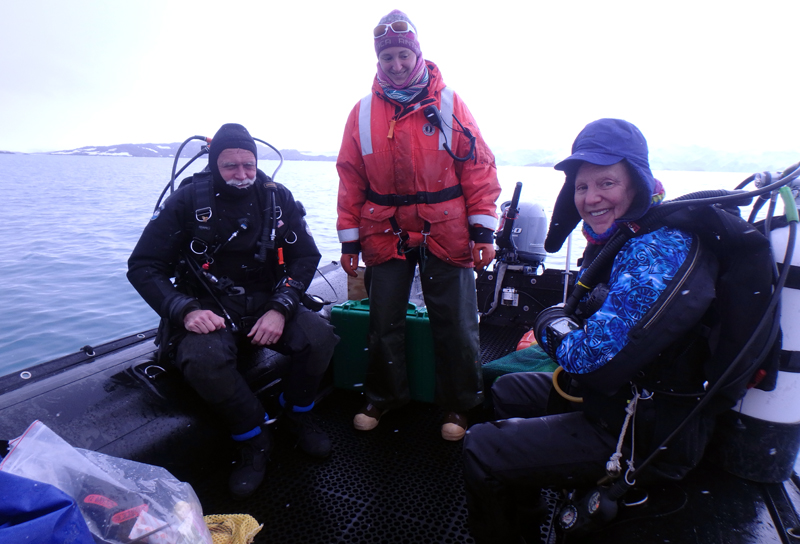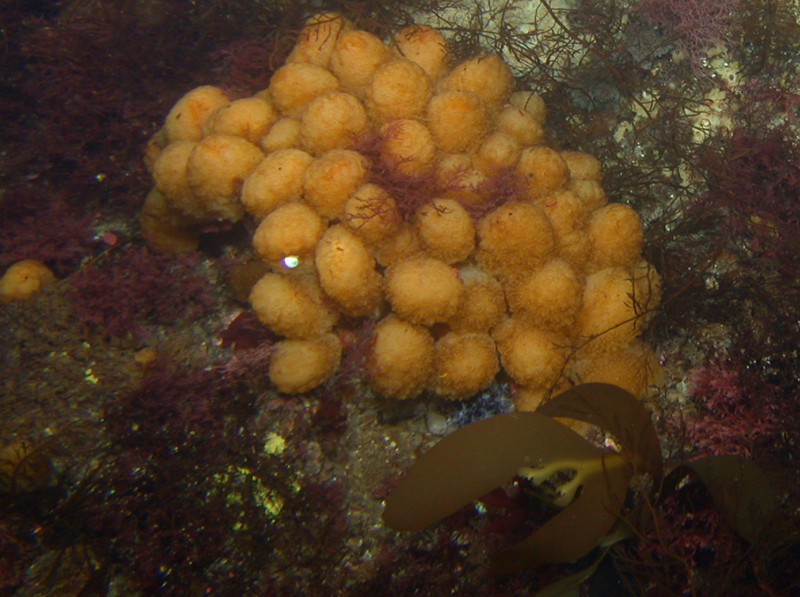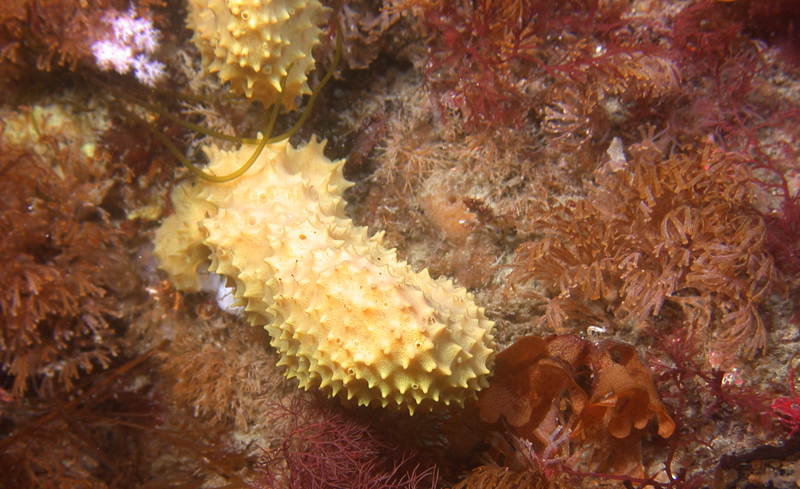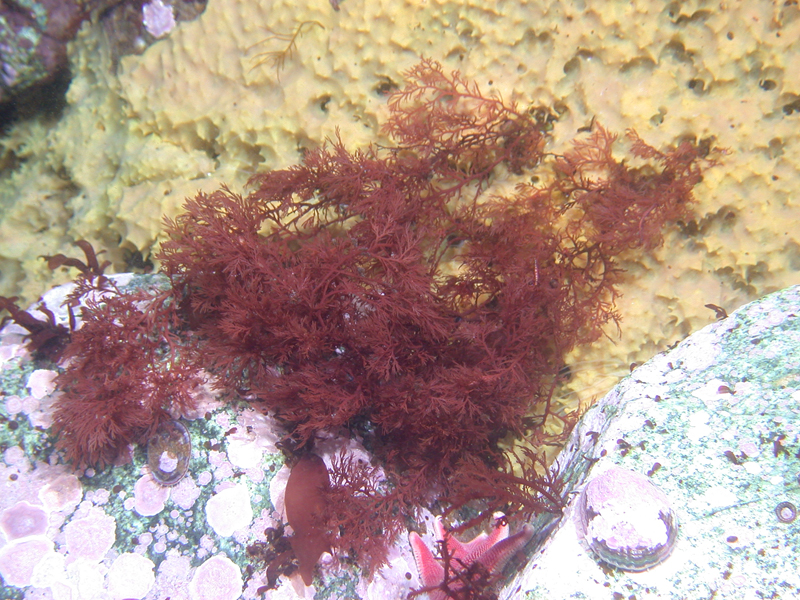 With the project’s initial diving priority of locating and assessing the 14 algal-bearing substrate experiments left over winter in the water well underway, yesterday Bill and I concentrated on collecting familiar organisms we have been studying for many years because of their intriguing chemistry. So, despite gusting winds and intermittent snow squalls, with tenders Sabrina doubling as zodiac captain and Chuck (taking picture) as first mate, we set out for a dive on nearby Gamage Point.
With the project’s initial diving priority of locating and assessing the 14 algal-bearing substrate experiments left over winter in the water well underway, yesterday Bill and I concentrated on collecting familiar organisms we have been studying for many years because of their intriguing chemistry. So, despite gusting winds and intermittent snow squalls, with tenders Sabrina doubling as zodiac captain and Chuck (taking picture) as first mate, we set out for a dive on nearby Gamage Point. Bill and I had two main invertebrates on our radar to look for. The first is a very distant relative of ours and yours too. Synoicum adareanum, a tunicate or sea squirt, like all vertebrates is a chordate even though a spineless and thus an invertebrate. Whether penguin, whale, human, or tunicate all share several common features in very early development. However, as the tunicate metamorphoses from a free-swimming larva to an attached adult, those commonalities, which include a rudimentary spinal cord, are lost. All vertebrates are chordates but not all chordates are vertebrates! Biology is tricky but so intriguing.
A little more about tunicate biology. Once attached the tunicate is sort of barrel-shaped with two siphons: one that draws water into the body (tunic) and the other that expels the water. While the seawater is inside the tunic, special cells filter out nutritious goodies from the seawater before being expelled. Some tunicates are solitary representing a single individual and bearing just one set of siphons. These can get baseball-sized and can also be washed up on the beach. Many a beachcomber has discovered why the common name for a solitary tunicate is sea squirt as upon a gentle squeeze of the tunic the water inside shoots out. Mother Nature’s water pistol.

Pictured above is a typical underwater view of our target tunicate Synoicum adareanum. It is not a single individual but rather 1000s of tiny individuals so it is called a colonial tunicate. Bill took this photo at 90 feet at another dive site a few years ago. The mound of interconnected yellow-orange balls is about the size of a basketball, the individual balls about the size of a lemon and are themselves colonial tunicates. The picture is thus that of a colony of colonial tunicates composed of 100s of 1000s of tiny tunicates inhaling, filtering and exhaling seawater. All bags of mostly water!
Following years of extensive underwater observations and experiments in the labs at Palmer Station, several unique chemical compounds, generally called secondary metabolites (as opposed to primary compounds which are involved in essential cell functions – e.g. for us hemoglobin for transporting oxygen in our blood) have been isolated from the tunic of Synoicum adareanum. As a side project the isolated compounds were sent to the National Institutes of Health for testing on a bunch of different cell lines involved in various human diseases. One compound, Palmerolide (named for Palmer Station), was found to very toxic to human skin cancer cells and many years from now after a lot of additional testing may be used in the fight against melanoma. No tunicates do not get skin cancer but we have yet to determine why such a compound is produced by the tunicate.

The other invertebrate Bill and I were in the hunt for was the bright yellow, spiky sponge Dendrilla membranosa. It is referred to as the cactus sponge and shown in the photo above, also taken by Bill. Again, through observations, experiments and lots of chemistry, several unique groups of secondary metabolites have been isolated from this sponge. The chemists call some of these metabolites membranolides. The project recently identified a different type of compound and named it Darwinolide (named indirectly for Charles Darwin for whom the taxonomic family containing Dendrilla is named). Like the tunicate’s Palmerolide compound, these sponge compounds show promise in treating human ailments including the contagious bacterial infection (MRSA) or the viral disease Herpes.

The cactus sponge also comes in a flatter variety and seems to have a different chemistry than its more upright form. We usually find the flatter form under a thick cover of algae as is shown above in another of Bill’s pictures with the bushy red alga Plocamium cartilagineum, Ploc, as Sabrina calls it, in the foreground. Bill, like Sabrina with the red alga, hopes to understand why the same species is so different chemically. Is it location or other neighbors in the area, or other factors we do not yet understand?
Whether invertebrates like tunicates and sponges or algae like Ploc, UAB is in Antarctica to study marine chemical ecology. So many organisms here produce unique secondary metabolites and in turn those compounds likely play a large role developing and maintaining the lush biodiversity of subtidal habitats around Palmer Station. It appears that humans may one day benefit from some of those compounds too. Nature has much wisdom to share not just regarding the fascinating organisms in Antarctic waters but even those in your own backyard.